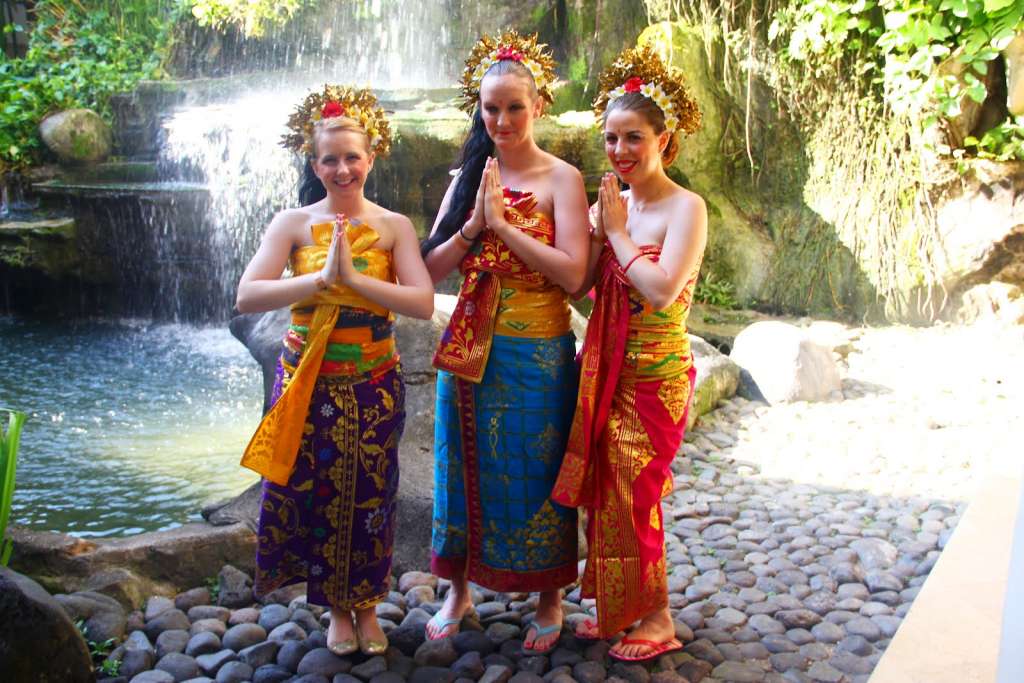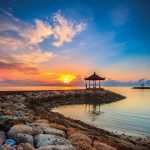Bali is small island, just 140 Km by 80 Km and lies between Java, the most highly populated and influential of all the islands, and Lombok, one of the quieter and moderately slower paced islands. Like many islands, Bali has developed a world of its own. It not only captures what is special about Indonesia but also has a uniqueness of its own. Bali, also known as the Goddess island, is an island with 1001 kinds of uniqueness, beauty and arts. In this pages you will get more information about Bali travel tips.
Bali Island, the perfect holiday destination for all ages offers something for everyone. Bali offers not just various customs but also various “adrenalin pump” parks. Many exciting amusements are available in Bali, with something new opening all the time. The number of offshore and inland attraction are on the rise because many tourists want them. This tropical paradise has a unique blend of modern tourist facilities combined with wonderful shopping and a rich past and heritage. After white water rafting that has gained popularity in Bali, comes offshore rafting or ocean rafting. The more adventurous sort of amusement has now become an alternative sport for bali tours and tourists. Meanwhile white water rafting is still a popular activity with trips on Ayung, Telaga Waja, Unda Rivers, etc. The tourists can refresh their mind by watching beautiful scenery along the route. Those are not enough, some of the best surfing beaches in the world can be found on the western side of the island whilst conversely the eastern side is a wonderful haven for families, with beautiful white sand beaches and gentle seas.
Geographic Condition
Size: 5.633 km2. Located between Bali Sea, Java Strait and the lndonesian Ocean It has a tropical climate with temperature of 24-34″C, and is often influenced by the climate in Australia as its close neighbor. Humidity is between 60-90%, which at times could reach 100%.
People
The people of Bali now feel disinclined to be divided into caste. ln their opinion, caste exists only to differentiate people’s kinds of jobs.
Brahmana are those who engage in spiritual life and religion, academia and intellectuals
Ksatria are those who work in the defense and security field or government offices
Wesia are those who engage in business and commerce
Sudra are those who do physical jobs and manual work
Balinese Iive on farming, tourism and related businesses or services, and art works.
As a community the inhabitants of Bali are bound by aspects of socio-cultural life which they call Tri Hita Karana (Three Obligations), narnely, the obligation to live a spiritual life as an atma (soul), the obligation to look after the land and its surrounding environment as angga (physic), and the obligation to live in
harmony with neighbours bound by rules and regulation as khaya (energy).
Bali Tours Religion
Balinese practice Hinduism in temples called Pure or Pura. In Hinduism there are several
holy days based on calendar dates: Based on the Balinese calendar
1. Galungan
\”tawur
bali tours : relegion
A day to commemorate the creation of the universe with all its contents and the victory of the good or duty (dharma) against the bad or evil deeds (adharma). On this day people present offerings to God (Sang Hyang Widhi) and all of its manifestations as the symbol of gratitude for His blessings and for people’s safety in future. ln 201 1 Galungan Day falls on July 6
2. Kuningan (from the word kuning meaning yellow)
Kuningan Day is commemorated every 210 days or once in six rnonths based on the Balinese calendar. (ln Balinese calendar 1 month is 35 days). On this day it is believed tlrat God descends to earth to give prosper- ity blessing to all human beings.The ceremony, it is said, is best conducted before noon, the time when angels return to heaven. On this day, yellow rice as a symbol of prosperity is cooked, and offerings as a symbol of gratitude for the blessings the Almighty has given are made. Offerings are in the form of food stuff and clothing materials which must be presented out of love and passion. ln 201 1 Kuningan Day falls on July 16
3. Saraswati
Saraswati is commemorated to honor God’s manifestation Aji Saraswati, goddess of science and literature. The day is celebrated every six months or every 210 days (which according to the Balinese calendar falls on Watugunung Umanis Saturday). Everyone rnakes offerings on books, dried palmyra/ palm leaf and other things related to literature and science as a symbol of gratitude for the descent of science and respect for it. A day after Saraswati is called Banyu Pinaruh which means water (banyu) of knowledge. The philosophy behind this is that when a man has mastered knowledge and is then awarded a degree, he is cleaned from any dirt remainder and his thought is purified which is symbolized in a procession of splattering holy water mixed with flowers on the person in a river or sea or in other source of water. A ritual that takes place in a river symbolizes a smooth flow of knowledge learned during Saraswati. A ritual conducted in sea water symbolizes the hope that the language learned becomes broader and deeper and functions as a melting point of illiteracy. A ritual that takes place in springs or other source of water symbolizes the hope that the gained knowledge becomes a source of enlightenment that life not only is for the self but is also for other people; and the gained knowledge must be used for the good.
4. Pagerwesi
Spiritually, it is a day to guard the self from negative influence by worshiping Hyang Pramesti Guru. Based on the Gregorian calendar
1. Nyepi (Silent)
Nyepi Day is commemorated every new Saka year. lts main goal is to ask for purification on mankind and the universe from the Almighty. Rituals conducted during this commemoration are:
a. Melasti or Melis/Mekiyis
Takes place two or three days before Nyepi On this day Hindu followers take sacred ornaments and decoration out of the temples (pura) and bring them to the beach or a lake to be splattered on. They are cleaned and splattered in the sea or Iakes because Balinese believe that sea and lake are the source of holy water (tirta amerta) and can be used to purify people and the universe.
b. Tawur (Pecaruan)
Tawur or Pecaruan is the purificition of bad spirits in the hope that all sins come off and disappear. This ritual is designated to the bad spirits requesting them not to disturb human beings.
c. Pengrupukan
This ritual is conducted to drive bad spirits away from the house, its surrounding and the neighborhood. Usually it is followed by a procession of man-like structure that looks ugly called oqoh-ogoh. Ogoh-ogoh which symbolizes bad spirits are carried around the neighborhood and then burned. lt is performed to drive bad spirits away from the neighborhood. On Nyepi Day there are four suspensions or prohibitions called Catur (Four) Berata (Suspension or Fasting) Penyepian, namely:
a. Amati Geni Suspension of producing fire (including electricity)
b. Amati karya Suspension of working
c. Amati lelanguan Suspension of having fun and entertainingone self
d. Amati Lelungaan
Prohibition to get out of the house and/or travel In 201 1 Nyepi Day falls on March 5
2. Siwaratri
Siwaratri is a holy day to worship God the Almighty {Hyang Widhi Wasa) and its mani festation in Sang Hyang Siwa (the god Siwa).
Bali Tours Ceremonies
Among traditional rituals or ceremonies still practiced in Bali these days are;
a. Pagedong-gedongan (A ceremony while a baby is still in its mother womb)
This ceremony is to ask for the health of the baby and its mother from God.
b. When the baby is born (Bayi Lahir)
A ceremony to offer gratitude for the birth of the baby, its weil being and that of its mother
c. Kepus Puser (the falling out of the babys navel cord It is a ritual to ask for protection of the baby from God when its navel cord comes off.
d. Tutug Kambuhan
A ceremony conducted when the baby is 42 days old to ask for the cleansing of the baby from any kinds of sins or evils. Holy water is splattered on the baby and its mother so that the mother can enter holy places such as Pure, Merajan and the like.
e. Nyambutin (Welcoming)
Nyambutin ceremony is conducted when the baby is 105 days. Ar this age the baby is considered to have reached a stage when he starts learning to sit. This ritual is conducted to ask for the complete return of the baby s soul into his body from God
f. Satu Oton (One year)
Satu oton or Otonan ceremony takes place when the baby is 210 days or 6 montl-rs (one year according to the Balinese calendar). lt is conducted so that the baby’s probable bad and evil traits (vices) which he might have on him can be reduced or redeemed in the hope that his present life is an opportunity to im- prove the self to the best it can be, As part of this otonan is the baby’s first hair cutting. lt is conducted to clean the crolarn of the head. This otonan ceremony also functions as a prayer to the Mother land for Her care about the baby so that he is free from difficulties, is safe and grows perfectly.
g. Munggah Daa (Becoming adult)
This ritual is to ask God for His guidance so that the person can control himself and cope with the transition period (fronr chiidren to adult). This ceremony is mainly for female because female is considered weak and bears a great responsibility and its consequences.
h. Metatah (Tooth Cutting/Trim)
ln this ceremony four of the upper teeth and two of canine teeth are cut or trimnred. This ceremony is conducted as a symbol of reaching adulthood and to reduce six of the lrr.rman vices that often degrade lruman beings, namely: lush, anger, greed, alcohol consumption and intoxication, confusion or imbalance, and jealousy. This ceremony lras two purposes. One is to wisir that the person in ques-
tion succeeds in life, is free from illnesses, is able to control himself and resist temptatron. Two is to wish that one day he or she is al, lowed to meet his ancestors and be united r,arith his Creator when he/ she dies.
i. Ngaben
Ngaben is a cremalion cerefitony of dead people. ln Hinduism dead bodjes are cremated in order to accelerate the return of elernents or substance that make up lrunran (physical) body.
ln addition to this, there are also traditional ceremonies which are related to the appearance of the moon such as purnanra (full moon) and Tilem (new moon).
https://www.youtube.com/watch?v=UWPvuIGBEAQ
Bali Tours Dance
Arts Bali is full of arts, one of which is dance. Below are dances still popular in Bali:
1. Kecak Dance
Also called the Monkey pance, Kecak Dance is derived from the Shanyang dance and con sidered sacred. Because of its sacredness it can only be performed in a temple (pura). Recently, however, this dance has been ad justed to suit tourists and it is often performed as entertainment. The adjustment is related to the story told in the dance by adopting the legendary Ramayana folk tale.
2. Pendet Dance
Similar to the Kecak Dance, originally this dance was also considered sacred and per formed to welcome gods who visited the earth. This dance too has experienced slight change and is performed to welcome visitors coming to Bali or to entertain tourists.
\”balinese
bali tours : dance
3. Legong Dance
It is also called Legong Keraton (kingt palace dance) which is an entertainrnent dance for the royal family.
4. Barong Dance
It is a battle dance between the good or virtues and the bad or vices. Traditional musical instrument in Bali is called Gamelan. lt consists of several pieces of instruments made of the mixture of metal, copper, and brass. But the most popular musi- cal instrument in Bali is Gambang. Gambang is made from bamboo and arranged like a piano. lt comes with a stick used to hit the Gambang. This instrument is often played solo in public places such as hotels and restaurants. People in Bali speak Balinese. Their second language is lndonesian. Although not many Balinese speak English (well), they have passive knowledge of English and understand people who speak to them in English.
2. Rent car (with or without a driver)
For those who wish to travel further and avoid getting caught in the rain, renting a car is a very good idea. A rent car without a driver costs 1 25,000 – 250,000 rupiah a day depending on the type of car. By adding IDR 100,000 to the budget You can have a driver’ Whichever you choose, don’t forget to insure the car you rent. This will cost you another IDR 25,000 a day.
3. Taxi
Compared to the two modes above, taxis cost higher. Whenever you use a taxi, choose the one with the fare meter.The tariff of the fare metered taxis is regulated by the government.
When you travel by taxi in Bali, pay attention to the distance of the location you want to go to. lf you don’t mind spending the time reading a map and you have a license, renting a vehicle is certainly cheaper and more flexible Balinese are very kind and willing to show you the direction if and whenever you get disoriented and ask.
Here are some rental places or spots in Bali for Bali Tours
MotorcYcle rental:
Rental Name: Bali RC
Address: Jl. Kubu AnYar 1 01 , Kuta
Phone: +62.361.923 24 42
Rental Name: E-Kuta
Address: Jl. Mertanadi, SeminYak
Phone: +62.361 .7977 824
Rental Name: JaYa
Address: Jl. Padma Utara, Kuta
Phone: +62.361 .7873 449
Places that rent out cars:
Rental Name: Amertha Dana
Address: Jl. Werkudara 104, Kuta
Phone: +62.361.7 44 9094
Rental Name: Aqus Merta
Address: Jl. Ciung Wanara 7, Kuta
Phone: +62.361.167 387
Rental Name: Bima Sakti
Address: Jl. Raya Kerobokan 26, Denpasar
Phone: +62.36 1’7 48 9036
Rental Name: Adira
Address: Jl.5unset Road 9994, Kuta
Phone: +62.361.756 999
Rental Name: Bali PusPa
Address: Jl. DhYana Pura 4, Kuta
Phone: +62.361 ’733 602
Rental Name: Emi Lestari
Address: Jl. Kartika Plaza 2x, Kuta
Phone: +62.361.754942
Taxis
Taxi Name: Blue Bird
One of Blue Bird! taxi ranks: Jl. Raya Kediri (in
front of Supermarket PePito), Kuta
Phone: +62.361.701 111
Taxi Name: Ngurah Rai / Bali Taxi
One of its taxi ranks: Jl. Raya Seminyak (in
front of Supermarket Bintang), Kuta
Phone: +62.361’724 724
Enjoy Bali Travel Tips





